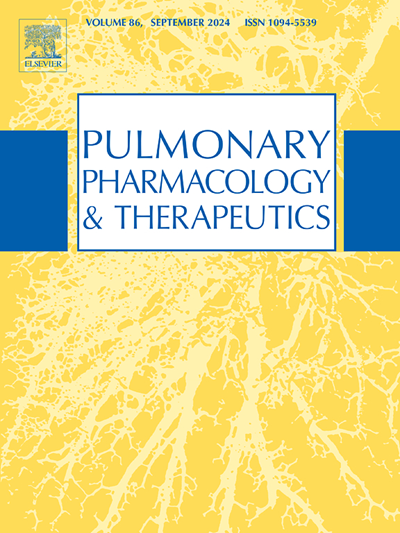杏仁核差向异构体通过抑制TGF-β1/Smad2/3途径发挥不同的抗肺纤维化活性。
IF 2.8
3区 医学
Q2 PHARMACOLOGY & PHARMACY
引用次数: 0
摘要
特发性肺纤维化(IPF)是一种慢性进行性组织修复反应,可导致不可逆的瘢痕形成和肺部重塑。苦杏仁汤在传统的肺部疾病临床应用中通常含有苦杏仁苷差向异构体。揭示苦杏仁苷差向异构体的细胞毒性和抗纤维化作用的差异,并探讨其潜在机制。用MRC-5评价苦杏仁苷差向异构体的细胞毒性 体外细胞。在博来霉素诱导的C57BL/6小鼠和TGF-β1诱导的MRC-5小鼠中评估了它们的抗纤维化活性 细胞。在这里,我们证明了在MRC-5中,L-苦杏仁苷比苦杏仁苷差向异构体毒性更大 并且D-苦杏仁苷在博来霉素诱导的C57BL/6小鼠中的苦杏仁苷差向异构体中更有效地抗肺纤维化。在此,观察到D-苦杏仁苷对炎症的抑制作用比L-苦杏仁苷更强,并且在抑制纤维化相关生物标志物的mRNA和蛋白质表达水平方面具有相似的结果。抗肺纤维化的机制表明,苦杏仁苷差向异构体抑制Smads2/3磷酸化的表达,这意味着TGF-β1诱导的Smads2/3信号通路失活。本研究评价了苦杏仁苷差向异构体的细胞毒性和抗纤维化作用,其机制与TGF-β1/Smads2/3信号通路有关。为苦杏仁苷差向异构体的临床安全性和有效性提供参考。本文章由计算机程序翻译,如有差异,请以英文原文为准。
Amygdalin epimers exert discrepant anti-pulmonary fibrosis activity via inhibiting TGF-β1/Smad2/3 pathway.
Idiopathic pulmonary fibrosis (IPF) represents a chronic and progressive tissue repair response that leads to irreversible scarring and lung remodelling. The decoction of bitter almond usually contains amygdalin epimers in traditional clinical application for lung disease. To reveal the differences of cytotoxicity and antifibrotic effect between amygdalin epimers, and potential mechanism is also explored. The cytotoxicity of amygdalin epimers were evaluated with MRC-5 cells in vitro. Their antifibrotic activities were evaluated in bleomycin-induced C57BL/6 mice and TGF-β1-induced MRC-5 cells. Here we demonstrated that L-amygdalin is more toxic of the amygdalin epimers in MRC-5 cells, and D-amygdalin is more effective in anti-pulmonary fibrosis among the amygdalin epimers in bleomycin-induced C57BL/6 mice. Herein, it was observed that D-amygdalin had a stronger inhibitory effect on inflammation than L-amygdalin, and had similar results in inhibiting the mRNA and protein expression levels of fibrosis-related biomarkers. The mechanism of anti-pulmonary fibrosis showed that amygdalin epimers suppressing expression of phosphorylation of Smads2/3, which implying deactivation of the TGF-β1induced Smads2/3 signal pathway. This study evaluates the amygdalin epimers cytotoxicity and antifibrotic effect, and its mechanisms were related to the TGF-β1/Smads2/3 signal pathway. It provides a reference for clinical safety and effectiveness of amygdalin epimers.
求助全文
通过发布文献求助,成功后即可免费获取论文全文。
去求助
来源期刊
CiteScore
6.20
自引率
0.00%
发文量
41
审稿时长
42 days
期刊介绍:
Pulmonary Pharmacology and Therapeutics (formerly Pulmonary Pharmacology) is concerned with lung pharmacology from molecular to clinical aspects. The subject matter encompasses the major diseases of the lung including asthma, cystic fibrosis, pulmonary circulation, ARDS, carcinoma, bronchitis, emphysema and drug delivery. Laboratory and clinical research on man and animals will be considered including studies related to chemotherapy of cancer, tuberculosis and infection. In addition to original research papers the journal will include review articles and book reviews.
Research Areas Include:
• All major diseases of the lung
• Physiology
• Pathology
• Drug delivery
• Metabolism
• Pulmonary Toxicology.

 求助内容:
求助内容: 应助结果提醒方式:
应助结果提醒方式:


